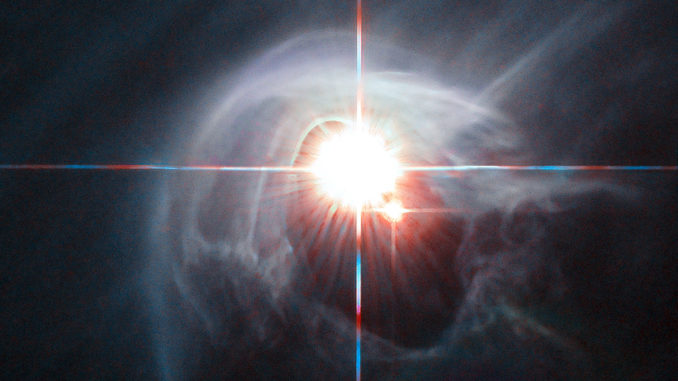
Mark your calendars for a must-see event! Astronomers have identified a Cataclysmic Variable (CV) binary star pair destined to become a red nova in the near future.
V Sagittae (abbreviated V Sge) is actually a pair of stars orbiting one another in the constellation Sagitta (The Arrow). They are not currently visible without at least a medium-size professional telescope. Evidence that scientist have presented indicates that the pair are destined to become a single star. When V Sge merges, it will for a short time become the brightest star in our galaxy. However, to earthlings it may only appear as bright as Sirius (the brightest star that can be seen from Earth) or possibly as bright as our neighbor planet Venus. This is because V Sge is very far away (at least 7300 light-years or more) and Sirius is very close (8.6 light-years) while Venus of course is right next door.
One of the two stars of V Sagittae is a white dwarf, and the other is described as a normal companion star. As they revolve around each other, the white dwarf is stealing mass from it’s companion. As it does, the two come closer, and the time it takes to complete one orbit decreases – which means they revolve faster and faster and get closer and closer to each other. Eventually they will reach a point called ‘runaway mass transfer’ and merge in an explosion that produces a red nova.
Bradley E. Schaefer, Juhan Frank, and Manos Chatzopoulos, who are astronomers at Louisiana State University, Department of Physics & Astronomy, presented their findings at the 235th Meeting of the American Astronomical Society (AAS) in Honolulu, Hawaii, which took place January 4th through the 8th, 2020. The name of their presentation: “The Unique Cataclysmic Variable V Sge is Increasing Its Accretion With a Doubling Timescale of 89 Years and Will InSpiral To Make a Red-Nova”. I think that says it all, don’t you?
Interesting facts about V Sagittae:
• The ‘V’ in V Sge does not stand for anything other than a designation to differentiate it from all the other stars in the constellation Sagitta.
• V Sge is unique in that it is the only known CV in which the white dwarf is smaller than the companion – in all other CV binary stars, the white dwarf is more massive than it’s companion
• V Sge is approximately 100 times brighter than any other known CV
• V Sge has an orbital period of just 12.34 hours
• The distance to V Sge is not precisely known – it is thought to be about
7760 light-years from Earth, plus 750 light-years or minus 460 light-years, but the distance is often rounded up and cited to be approximately 7,800 light-years.
The scientists estimate that the merge will occur sometime around the year 2083, plus or minus sixteen years. In other words, it could occur as early as 2067 but no later than 2099. That’s just a blink of an eye away, astronomically speaking. Get out your calendars and pencil it in!
Oh, and if you’re not willing to wait that long, there is another red nova predicted to occur in 2022, but alas, it will not be as bright V Sagittae.
Question of the night: Are you a fan of the Britcom, Red Dwarf?
